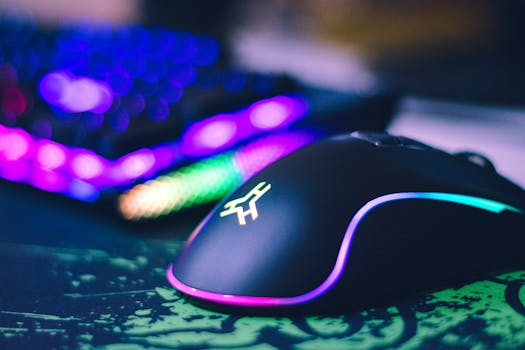My mousepad looked fine, a little worn, but nothing alarming. Turns out, years of accumulated skin cells, crumbs, and general desk grime had turned it into a biohazard. Here's how I tackled the cleaning process and learned a valuable lesson about desk hygiene.

We often overlook the unsung heroes of our desks, the silent workhorses that facilitate our daily digital lives. I'm talking about the humble mousepad. It sits there, absorbing spills, collecting dust bunnies, and generally enduring a life of quiet servitude. Mine looked okay, a little faded perhaps, but nothing that screamed “biohazard.” I was so wrong. The cleaning journey that followed revealed a truth so unsettling, it compelled me to share my experience and, hopefully, inspire you to take action. Let's dive in.
The Denial Stage: "It Doesn't Look That Dirty"
For years, I operated under the assumption that my mousepad was reasonably clean. I mean, I wasn’t actively spilling coffee on it, and I occasionally wiped it down with a dry cloth. What more could a mousepad ask for? The reality, as I soon discovered, was far more grim.
# The Wake-Up Call: A Deep Dive into Desk Hygiene
My moment of reckoning came during a particularly slow workday. Boredom led me to Google, and I stumbled upon an article about the shocking amount of bacteria lurking on office desks. The images were horrifying: keyboards teeming with germs, phones coated in grime, and, yes, mousepads harboring entire ecosystems. The article suggested that mousepads, due to their porous nature and constant contact with our hands, are breeding grounds for all sorts of nasties. I cringed.
The Cleaning Process: A Step-by-Step Guide
Armed with newfound knowledge and a healthy dose of disgust, I decided to tackle the cleaning process. Here’s what I did:
# Step 1: Inspection and Preparation
Before diving in, I took a good, hard look at my mousepad. I noticed a subtle discoloration, particularly around the areas where my wrist and hand rested. There were also a few crumbs clinging stubbornly to the surface. I gathered my cleaning supplies: dish soap, warm water, a soft-bristled brush (an old toothbrush worked perfectly), and a clean microfiber cloth.
# Step 2: The Gentle Scrub
I filled a sink with warm water and added a few drops of dish soap. I then submerged the mousepad and gently scrubbed the surface with the brush, paying extra attention to the stained areas. The water quickly turned a disturbing shade of brown. It was a visual representation of years of accumulated grime. I was horrified, but also strangely satisfied.
Tip: Avoid using harsh chemicals or abrasive cleaners, as these can damage the surface of your mousepad.
# Step 3: Rinse and Repeat (If Necessary)
After scrubbing, I thoroughly rinsed the mousepad under running water until all traces of soap were gone. The water ran clear, but I wasn't convinced. I repeated the scrubbing and rinsing process one more time, just to be sure.
# Step 4: The Drying Process
This is a crucial step. Improper drying can lead to mold and mildew growth, defeating the purpose of cleaning in the first place. I gently squeezed out any excess water and then laid the mousepad flat on a clean towel. I placed another towel on top and pressed down to absorb even more moisture. Finally, I left the mousepad to air dry completely, which took about 24 hours.
Tip: Avoid using a hairdryer or placing the mousepad in direct sunlight, as this can warp the material.
The Aftermath: A Revelation
The next day, my mousepad was completely dry. The difference was astounding. The colors were brighter, the surface was smoother, and it felt cleaner to the touch. It was like having a brand new mousepad, without the expense of actually buying one. More importantly, I felt a sense of accomplishment and a newfound appreciation for desk hygiene.
# The Lesson Learned: Regular Cleaning is Key
My mousepad cleaning adventure taught me a valuable lesson: regular cleaning is essential, even if things look clean. Now, I make it a point to wipe down my mousepad at least once a week with a damp cloth. I also plan to give it a more thorough cleaning every month or so. It's a small effort that makes a big difference in terms of hygiene and overall desk cleanliness.
Beyond the Mousepad: Extending the Cleaning Ritual
Inspired by my mousepad transformation, I decided to extend my cleaning ritual to other areas of my desk. I wiped down my keyboard, cleaned my monitor, and even dusted my desk drawers. The result was a workspace that felt cleaner, more organized, and more conducive to productivity.
# Additional Tips for a Clean Workspace
- Invest in a keyboard cover: This will protect your keyboard from dust, crumbs, and spills.
- Use compressed air to clean hard-to-reach areas: This is especially useful for cleaning between keyboard keys.
- Keep hand sanitizer on your desk: Use it regularly to prevent the spread of germs.
- Declutter regularly: A cluttered desk is a breeding ground for dust and grime.
Conclusion: A Cleaner Desk, a Clearer Mind
Cleaning my filthy mousepad was a surprisingly rewarding experience. It not only improved the hygiene of my workspace but also boosted my overall sense of well-being. So, take a look at your mousepad. Is it time for a cleaning intervention? You might be surprised by what you discover. A cleaner desk leads to a clearer mind, and that's something we can all benefit from.
